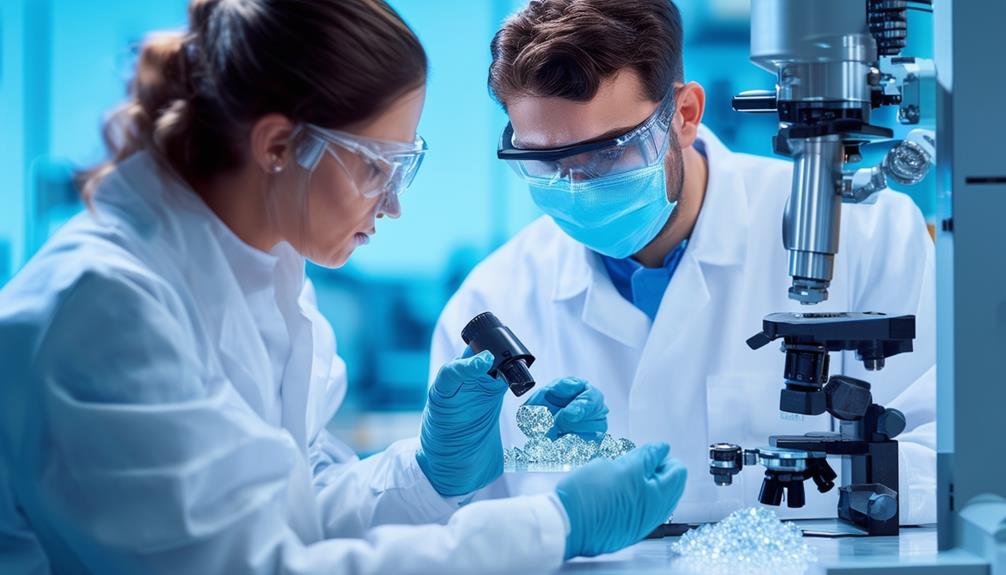Article Contents
When comparing the costs of lab-grown diamond production methods, it’s crucial to distinguish between High Pressure High Temperature (HPHT) and Chemical Vapor Deposition (CVD). HPHT requires significant energy consumption and advanced machinery, which, while costly, may scale efficiently. Conversely, CVD uses less energy and fewer materials, contributing to gradual improvements in both quality and environmental impact.
Both methods necessitate a skilled workforce to ensure efficient operations. The initial capital investment for the equipment is considerable. A thorough understanding of these elements is essential for evaluating the cost-effectiveness and broader economic implications of each method.
Key Points
- The CVD method is more energy-efficient, which can lead to lower operational costs than the HPHT method.
- Setting up a CVD facility requires an initial investment ranging between $1 million and $5 million.
- The HPHT method involves the use of expensive, energy-demanding equipment and requires precise control systems to operate effectively.
- Both CVD and HPHT techniques require skilled labour, which significantly influences the production costs.
- Due to its energy efficiency and lower operational requirements, the CVD method is more scalable, potentially reducing the cost per unit in mass production scenarios.
Understanding HPHT Production Costs
The production costs for HPHT (High Pressure High Temperature) lab-grown diamonds are largely due to the need to simulate the extreme conditions found deep within the Earth, where natural diamonds form. This process requires advanced, energy-intensive equipment capable of generating and maintaining high pressures and temperatures. The investment in high-quality machinery and the significant energy needed are major contributors to the costs involved.
Moreover, maintaining high-quality standards for these lab-created diamonds necessitates precise control systems and thorough processes, which add to the overall expense. However, the appeal of HPHT production lies in its potential for cost-efficiency and scalability. Advancements in techniques and improvements in equipment efficiency can lead to increased production and potentially lower costs per unit. This scalability is crucial for addressing growing market demands and maintaining the option to choose between natural and lab-grown diamonds.
Investing in HPHT technology promotes the availability of diamonds, supporting innovation and contributing to sustainability in the jewellery industry. This approach not only meets consumer demand but also aligns with ethical considerations by providing an environmentally friendly alternative to mined diamonds.
Analysing CVD Method Expenses
Analysing the expenses associated with the Chemical Vapor Depression (CVD) method for diamond production, it is evident that this technique is generally cost-effective due to its lower energy consumption. The CVD process incurs significant costs in materials and necessitates advanced equipment and specialised gases. Despite the substantial initial investment required for this technology, the scalability of the CVD process compensates by facilitating mass production.
Ongoing research and development are crucial for enhancing the CVD method to produce superior quality diamonds, which can lead to more competitive market pricing. Continued enhancements in the technique can improve both the yield and the quality of the diamonds, thereby reducing the overall cost structure. Below is a summary of the primary expense categories:
| Expense Category | Details |
|---|---|
| Initial Setup | Advanced equipment, specialised gases |
| Operational Costs | Maintenance, energy, material replenishment |
| Research & Development | Enhancements in growth process, quality control |
| Market Influence | Impact of production scale, diamond quality on pricing |
Understanding these expenses highlights the economic advantages of the CVD method, making it an appealing choice for efficient and advanced diamond production.
Comparing Energy Consumption
Energy consumption varies significantly between the High Pressure-High Temperature (HPHT) and Chemical Vapor Deposition (CVD) methods, both of which are used to create lab-grown diamonds. These techniques not only impact energy efficiency but also influence production costs.
- HPHT Method: This method necessitates a large amount of energy to imitate the harsh conditions needed for natural diamond formation, resulting in higher operational costs due to its energy-intensive nature.
- CVD Method: Recognised for its energy efficiency, this method operates under less extreme conditions by ionising carbon-rich gases in a controlled setting, enabling diamonds to form gradually with lower energy usage.
- Cost Considerations: The CVD process typically involves lower production costs compared to the HPHT method due to its reduced energy requirements.
- Environmental Effects: With growing concerns over energy usage, the CVD method is seen as a more sustainable choice that may help decrease the carbon footprint linked to diamond production.
- Market Trends: In light of the shift towards sustainable practices, the energy-efficient CVD method is gaining popularity in the market, reflecting evolving consumer preferences.
It is essential for stakeholders to understand these distinctions to make well-informed decisions that support both economic and environmental objectives in diamond production.
Assessing Skilled Labour Impact
While energy factors influence production costs, skilled labour is equally crucial in shaping the economics of lab-grown diamond manufacturing. A skilled workforce ensures precise crafting of each gem, significantly affecting price implications. The artisans’ proficiency in cutting, polishing, and grading diamonds enhances labour efficiency and cost-effectiveness throughout the production process.
The table below summarises the impact of skilled labour on different aspects of lab-grown diamond production:
| Aspect | Impact on Cost | Role of Skilled Labour |
|---|---|---|
| Quality Assurance | High | Crucial for maintaining value |
| Craftsmanship | Moderate | Enhances labour efficiency |
| Final Product Value | High | Vital for pricing |
Skilled labour is integral to both the intrinsic quality and market competitiveness of lab-grown diamonds. The detailed processes involved in diamond creation highlight the necessity for a well-trained, competent workforce. This is a key factor in the financial and artistic success of lab-grown diamond manufacturing.
Assessing the costs of equipment and facilities
The financial implications of equipment and facility expenditures significantly impact the total investment in lab-grown diamond production through methods like CVD (Chemical Vapor Deposition) and HPHT (High Pressure High Temperature). These costs are crucial for businesses entering this field to consider for effective budgeting and maintaining economic sustainability.
- Initial Equipment Costs: Setting up a CVD operation typically requires an investment ranging from $200,000 to $500,000 in equipment, whereas HPHT equipment costs are similar, ranging from $100,000 to $500,000.
- Facility Investment: Establishing a CVD facility can cost between £1 million and £5 million. HPHT facilities require a comparable level of financial commitment.
- Specialised Equipment: Both CVD and HPHT technologies involve specific, costly equipment essential for ensuring product quality and operational efficiency.
- Safety and Infrastructure: HPHT operations require robust safety protocols, which contribute significantly to the overall infrastructure costs.
- Cost-Benefit Analysis: Conducting thorough cost-benefit analyses is vital for understanding potential returns on investment and aids in strategic financial planning.
Incorporating these financial considerations into business planning helps companies effectively navigate the economic complexities associated with the lab-grown diamond industry, ensuring informed decision-making and strategic alignment.
Frequently Asked Questions
How do lab-grown diamonds compare in price?
Lab-grown diamonds typically cost 30-40% less than their mined counterparts. This pricing reflects a shift towards more sustainable and economical options in the gemstone market. Opting for lab-grown diamonds allows consumers to prioritise both quality and beauty without compromising on ethical and financial considerations.
Which method of lab-grown diamond is superior?
The best method for creating lab-grown diamonds varies based on specific priorities such as minimising environmental impact or optimising production efficiency. The High Pressure High Temperature (HPHT) and Chemical Vapor Deposition (CVD) techniques both offer distinct advantages. Choosing between them often depends on the specific environmental or economic goals of the individual or organisation involved.
How do you compare diamond prices?
To effectively compare diamond prices, you should analyse the current market trends and explore various retailers. Prioritise the 4Cs—cut, colour, clarity, and carat—which significantly influence a diamond’s value. Additionally, consider the promotions available and the potential long-term value to ensure your purchase is economical and trustworthy.
What is the true cost of a lab-grown diamond?
The energy-intensive manufacturing process and current market conditions impact the actual cost of a lab-grown diamond. These diamonds offer an ethical and more cost-effective option than natural diamonds, maintaining high quality while minimising environmental impact.
Conclusion
In conclusion, the cost analysis of lab-grown diamond methods such as High Pressure High Temperature (HPHT) and Chemical Vapor Deposition (CVD) reveals significant differences. These variations stem from their distinct energy requirements, the need for specialised labour, and the initial investment in technology and infrastructure.
Understanding these cost factors is crucial for investors and guides the development of sustainable and profitable synthetic diamond manufacturing.
Discover More About the Costs of Lab-grown Diamond Methods
1: https://www.gemsociety.org/article/lab-grown-diamond-pricing/
2: https://www.queensmith.co.uk/diamond-guides/lab-grown-diamonds/lab-grown-diamonds-price-and-value
3: https://www.diamonds.pro/education/lab-created-diamonds/
4: https://www.britinsurance.com/news/lab-grown-diamonds
5: https://nightingale.co.uk/blogs/says/how-much-are-lab-diamonds-worth-cost-resale-value-explained



